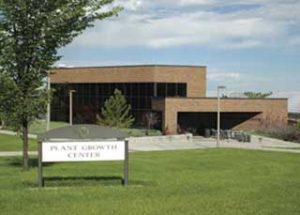
From MSU News Service
Thirty years ago, Montana State University research into plants and soils was at a crossroads: The university’s facility where this research was conducted was small, stifling growth and lacking some critical infrastructure — such as adequate cooling and exhaust systems — that made it difficult to obtain consistent, accurate research results.
The university and its partners made a pitch to the Montana Legislature for $5.3 million to build a new facility. Now, one legislative appropriation and three decades later, the Plant Growth Center at MSU has enabled hundreds of research projects that have contributed important knowledge to Montana and beyond. The Plant Growth Center also features labs, classrooms, and an insect quarantine unit.
“This facility has enabled an enormous amount of research,” said David Baumbauer, Plant Growth Center manager. That work ranges from disease testing on seed potatoes, to biodiesel production with algae, to weed management, to starting vegetables from seeds for MSU’s student-run vegetable farm, to studying pollinator-plant interactions, to developing wheat varieties that will perform well in Montana’s varied landscape.
The Plant Growth Center runs like a hotel, Baumbauer said. People who would like to use space in the facility submit a request for a reservation, along with information about their desired start and end dates, environmental requirements, and other details. Baumbauer then works to find appropriate space to fill the request.
Projects using space in the Plant Growth Center can last anywhere from three months to 30 years, he added.
Funded entirely by the 1983 Montana Legislature, construction on the MSU Plant Growth Center started in 1985. Part of the facility opened in the fall of 1986, and its formal dedication was held in April 1987.
Baumbauer — who, earlier this year, marked his 30th anniversary of managing the Plant Growth Center — noted that, from the beginning, some of the facility’s biggest champions were members of the greater Montana agricultural community.
“It enjoyed tremendous support from the ag community,” he said. “All of these commodity groups and ag groups from across the state went to Helena to testify for the need for a modern plant growth facility.
“The Plant Growth Center is more than just a university building,” he added. “It really does belong to the ag community. They fought really hard for the funding.”
President Bill Tietz, who headed the university at the time, championed the notion that the facility should be located in the main part of campus, and thus accessible to the university community at large, Baumbauer added. The Plant Growth Center is located on 11th Avenue, across the street from Linfield Hall.
“Many universities set (a facility like the Plant Growth Center) out on the edge of campus,” he said. “We’re not located far from the campus core.”
The building itself was designed with high-tech systems that regulate temperature and light. Its energy-saving features include a heat recovery system, where waste heat from water-cooled growth chambers and growth rooms is used to heat the greenhouses, Baumbauer said.
Although the building has remained largely unchanged, a few updates and remodels have been completed in more recent years. In the 1990s, for instance, more greenhouse space was added, as well as a number of growth chambers.
Use of the Plant Growth Center has grown substantially over the years, according to Baumbauer. Previously, 25 to 30 researchers would use space each quarter; now, he said, that number has grown to 45 to 50. And, he noted that many of the researchers are from disciplines outside the College of Agriculture, including ecology, biological engineering and chemistry.
Charles Boyer, vice president for agriculture, said it’s fitting that MSU — the state’s cornerstone land-grant university — hosts a facility that advances agricultural research throughout the state.
“We are so proud of the research that has come out of this facility, as well as the impact that research has had on our state,” Boyer said. “We know that the Plant Growth Center has strengthened Montana’s agriculture landscape and horticulture industries.” •






